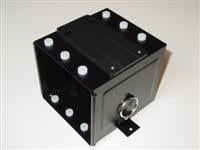Antec Mini-P180 Advanced Mini Tower
Antec Mini-P180 Interior Shots

The inside of the Mini-P180 features two main zones; the upper chamber will house the motherboard and optical drives, as well as up to five hard drives and the lower one is mainly used to house the power supply unit and two additional 5 1/4" bays. The uppermost bay will fit most newer optical drives, but Antec does warn that size constraints are limited to 170mm or less as they would otherwise hit the fan housing. A sliding door separates the two zones and helps keep cables organized. The entire interior including the removable drive cages are anodized black, which is a nice touch.
Silicone grommets under the PSU and in the drive cages limit vibration between the components and the chassis to keep unwanted noise output to a minimum. One doesn't usually expect much in the way of a bundle with a case, but Antec has thrown in a 5 1'4" to 3 1/2" conversion kit to allow floppy drives or card readers to be installed, as well as four tie-downs, 6 rails for optical drives, and the requisite screws and standoffs. One of the drive bays also has a compartment for storing these extra screws and other small items that one might need for later upgrades.
Both the rear and top-mounted fans require 4-pin MOLEX power, which we weren't overly keen on (we'd prefer 3-pin plugs that connect directly to the motherboard), but we really liked how the speed controls were worked into the back of the Mini-P180. This allowed for refinement of noise/cooling levels without the opening of the chassis. In the Antec Nine and Three Hundreds, the speed controls dangle on cables and we needed to tuck them in or tie them down to keep them out of trouble within the system, and also required that we open the case to change speeds which can become a hassle.
Plenty of room under the motherboard and right side panel allow cables to be routed and tied down, keeping them organized and out of the way of the other components. There are openings near the top, alongside the cages, and in the bottom zone providing unrestricted access to route the cables to each zone accordingly. Cables snake down from the front for the HD Audio, USB, and eSATA (goes into an open SATA port), with power button, reset button, and power LED leads.















